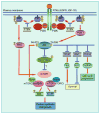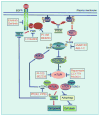Targeting the RTK-PI3K-mTOR axis in malignant glioma: overcoming resistance
- PMID: 20535652
- PMCID: PMC3012004
- DOI: 10.1007/82_2010_67
Targeting the RTK-PI3K-mTOR axis in malignant glioma: overcoming resistance
Abstract
Gliomas represent the most common primary brain tumor and among the most aggressive of cancers. Patients with glioma typically relapse within a year of initial diagnosis. Recurrent glioma is associated with acquired therapeutic resistance. Although neurosurgical resection, radiation and chemotherapy provide clear benefit, survival remains disappointing. It is, therefore, critical that we identify effective medical therapies and appropriate tumor biomarkers in patients at initial presentation, to promote durable responses in glioma. Pathways linking receptor tyrosine kinases, PI3 kinase, Akt, and mTOR feature prominently in this disease and represent therapeutic targets. Small molecules that inhibit one or more of these kinases are now being introduced into the clinic and may have some activity. Disappointingly, however, preclinical studies demonstrate these agents to be primarily cytostatic rather than cytotoxic to glioma cells. Here, we detail activation of the EGFR-PI3K-Akt-mTOR signaling network in glioma, review class I PI3K inhibitors, discuss roles for Akt, PKC and mTOR, and the importance of biomarkers. We further delineate attempts to target both single and multiple components within the EGFR-PI3K-Akt-mTOR axes. Lastly, we discuss the need to combine targeted therapies with cytotoxic chemotherapy, radiation and with inhibitors of survival signaling to improve outcomes in glioma.
Figures


Similar articles
-
NVP-BEZ235, a novel dual PI3K-mTOR inhibitor displays anti-glioma activity and reduces chemoresistance to temozolomide in human glioma cells.Cancer Lett. 2015 Oct 10;367(1):58-68. doi: 10.1016/j.canlet.2015.07.007. Epub 2015 Jul 15. Cancer Lett. 2015. PMID: 26188279
-
Targeting RTK-PI3K-mTOR Axis in Gliomas: An Update.Int J Mol Sci. 2021 May 5;22(9):4899. doi: 10.3390/ijms22094899. Int J Mol Sci. 2021. PMID: 34063168 Free PMC article. Review.
-
Multipoint targeting of the PI3K/mTOR pathway in mesothelioma.Br J Cancer. 2014 May 13;110(10):2479-88. doi: 10.1038/bjc.2014.220. Epub 2014 Apr 24. Br J Cancer. 2014. PMID: 24762959 Free PMC article.
-
Overcoming acquired resistance to anticancer therapy: focus on the PI3K/AKT/mTOR pathway.Cancer Chemother Pharmacol. 2013 Apr;71(4):829-42. doi: 10.1007/s00280-012-2043-3. Epub 2013 Feb 3. Cancer Chemother Pharmacol. 2013. PMID: 23377372 Review.
-
Combination of PI3K and MEK inhibitors yields durable remission in PDX models of PIK3CA-mutated metaplastic breast cancers.J Hematol Oncol. 2020 Feb 22;13(1):13. doi: 10.1186/s13045-020-0846-y. J Hematol Oncol. 2020. PMID: 32087759 Free PMC article.
Cited by
-
DNA methylation-regulated LINC02587 inhibits ferroptosis and promotes the progression of glioma cells through the CoQ-FSP1 pathway.BMC Cancer. 2023 Oct 17;23(1):989. doi: 10.1186/s12885-023-11502-0. BMC Cancer. 2023. PMID: 37848823 Free PMC article.
-
Oligodendroglioma: A Review of Management and Pathways.Front Mol Neurosci. 2021 Oct 5;14:722396. doi: 10.3389/fnmol.2021.722396. eCollection 2021. Front Mol Neurosci. 2021. PMID: 34675774 Free PMC article. Review.
-
Targeting the VEGF and PDGF signaling pathway in glioblastoma treatment.Int J Clin Exp Pathol. 2015 Jul 1;8(7):7825-37. eCollection 2015. Int J Clin Exp Pathol. 2015. PMID: 26339347 Free PMC article.
-
The Gene Expression Status of the PI3K/AKT/mTOR Pathway in Gastric Cancer Tissues and Cell Lines.Pathol Oncol Res. 2016 Oct;22(4):797-805. doi: 10.1007/s12253-016-0066-5. Epub 2016 May 7. Pathol Oncol Res. 2016. PMID: 27156070 Free PMC article.
-
Current trends in targeted therapies for glioblastoma multiforme.Neurol Res Int. 2012;2012:878425. doi: 10.1155/2012/878425. Epub 2012 Mar 5. Neurol Res Int. 2012. PMID: 22530127 Free PMC article.
References
-
- Brandes AA, Franceschi E, Tosoni A, Hegi ME, Stupp R. Epidermal growth factor receptor inhibitors in neuro-oncology: hopes and disappointments. Clin Cancer Res. 2008;14:957–960. - PubMed
-
- Chang SM, Wen P, Cloughesy T, Greenberg H, Schiff D, Conrad C, Fink K, Robins HI, De Angelis L, Raizer J, et al. Phase II study of CCI-779 in patients with recurrent glioblastoma multiforme. Invest New Drugs. 2005;23:357–361. - PubMed
-
- Chen JS, Zhou LJ, Entin-Meer M, Yang X, Donker M, Knight ZA, Weiss W, Shokat KM, Haas-Kogan D, Stokoe D. Characterization of structurally distinct, isoform-selective phosphoinositide 3′-kinase inhibitors in combination with radiation in the treatment of glioblastoma. Mol Cancer Ther. 2008;7:841–850. - PubMed
Publication types
MeSH terms
Substances
Grants and funding
LinkOut - more resources
Full Text Sources
Other Literature Sources
Medical
Research Materials
Miscellaneous

